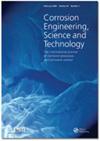Topographical profiles and mechanical property of corrosion product films on a pipeline steel in Desulfovibrio vulgaris -containing thin electrolyte layer characterised by atomic force microscopy
IF 1.5
4区 材料科学
Q4 MATERIALS SCIENCE, MULTIDISCIPLINARY
Corrosion Engineering, Science and Technology
Pub Date : 2023-09-19
DOI:10.1080/1478422x.2023.2259668
引用次数: 0
Abstract
ABSTRACTInternal corrosion of wet gas pipelines usually occurs in thin layers of water condensate with dissolved gases such as CO2, where a bacterial community can grow to cause microbiological corrosion. In this work, surface films generated during corrosion of an X52 pipeline steel under a CO2-containing thin electrolyte layer (TEL) in the absence and presence of Desulfovibrio vulgaris bacteria were characterised by atomic force microscopy. The film generated in the Desulfovibrio vulgaris-containing TEL, i.e. a mixture of FeS, FeCO3 and biopolymers, as compared with the film generated in the sterile TEL (i.e. FeCO3-dominant corrosion products), is topographically less compact and softer, with a reduced elastic modulus. After 7 days of immersion, the elastic modulus of the surface films generated in the sterile and D. vulgaris-containing TELs are 11.81 and 6.79 GPa, respectively.KEYWORDS: Corrosion product filmstopographymechanical propertyatomic force microscopymicrobiological corrosionthin electrolyte layer AcknowledgementsThis work was supported by Excellence in Doctoral Student Studies Program of the University of Science and Technology of China, and the University of Calgary, Canada.Disclosure statementNo potential conflict of interest was reported by the authors.Additional informationFundingThis work was supported by University of Science and Technology of China.用原子力显微镜观察含脱硫弧菌薄电解质层中管道钢腐蚀产物膜的形貌和力学性能
【摘要】湿气管道的内部腐蚀通常发生在含有溶解气体(如CO2)的薄层冷凝水中,细菌群落可能在其中生长,导致微生物腐蚀。在这项工作中,用原子力显微镜对X52管道钢在含二氧化碳的薄电解质层(TEL)下,在无脱硫弧菌存在的情况下,腐蚀过程中产生的表面膜进行了表征。与无菌TEL(即FeCO3为主的腐蚀产物)中生成的膜相比,含脱硫弧菌TEL中生成的膜(即FeS, FeCO3和生物聚合物的混合物)在形貌上不致密,更柔软,弹性模量降低。浸渍7 d后,无菌和含紫菜苔藻的苔藻表面膜的弹性模量分别为11.81和6.79 GPa。关键词:腐蚀产物薄膜形貌;力学性能;原子力显微镜;微生物腐蚀;薄电解质层。披露声明作者未报告潜在的利益冲突。本研究由中国科学技术大学资助。
本文章由计算机程序翻译,如有差异,请以英文原文为准。
求助全文
约1分钟内获得全文
求助全文
来源期刊

Corrosion Engineering, Science and Technology
工程技术-材料科学:综合
CiteScore
3.20
自引率
5.60%
发文量
58
审稿时长
3.4 months
期刊介绍:
Corrosion Engineering, Science and Technology provides broad international coverage of research and practice in corrosion processes and corrosion control. Peer-reviewed contributions address all aspects of corrosion engineering and corrosion science; there is strong emphasis on effective design and materials selection to combat corrosion and the journal carries failure case studies to further knowledge in these areas.
 求助内容:
求助内容: 应助结果提醒方式:
应助结果提醒方式:


